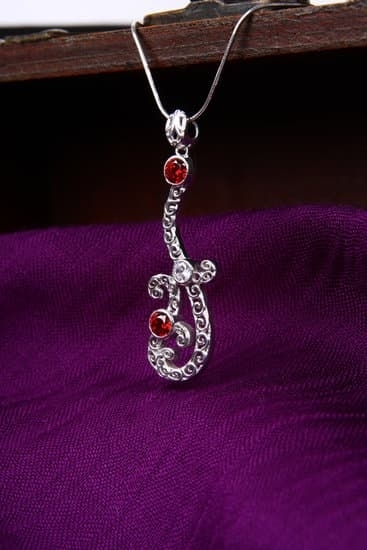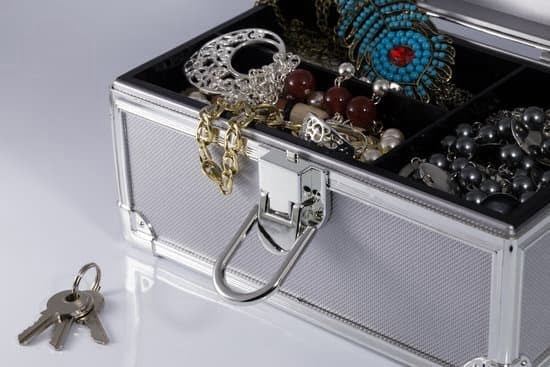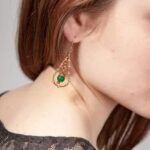The 1920s was a time of extravagant elegance and artistic innovation, and nowhere is this more apparent than in the world of jewelry. Art Deco, a style characterized by bold geometric shapes and exquisitely intricate designs, took the era by storm, leaving an indelible mark on the history of fashion.
In this article, we will delve into the enchanting allure of 1920 Art Deco jewelry – its origins, aesthetics, gemstones, designers, motifs, and the way it reflects the spirit of the Roaring Twenties. Join us as we explore this captivating era and uncover the timeless beauty of these exquisite masterpieces.
Art Deco emerged in parallel with rapid social and technological advancements during the early twentieth century. Its roots can be traced back to several influences such as Cubism, Bauhaus design principles, ancient Egyptian art, and even ancient Central American cultures like Maya and Aztec. This unique blend of inspirations resulted in a strikingly modern style that captured the imagination of fashion-conscious individuals across the globe.
One cannot discuss 1920s Art Deco jewelry without noting its distinctive aesthetic marvel. Characterized by clean lines, geometrical patterns, symmetric shapes, and sharp angles; these pieces exude a sense of boldness and sophistication unparalleled by any other period. From diamond necklaces dripping with elegance to geometrically shaped brooches set with vibrant gemstones – every piece exemplifies meticulous craftsmanship that became synonymous with Art Deco.
As we embark on this journey into 1920 Art Deco jewelry, prepare to be amazed by its opulence and intricacy. Discover how this remarkable era continues to influence contemporary fashion trends as we unravel the secrets behind its masterminds’ creations.
The Origins and Influences of Art Deco
The Art Deco movement of the 1920s was not created in a vacuum. It was influenced by a variety of artistic and cultural movements that came before it. Understanding these influences is key to appreciating the origins of Art Deco jewelry.
1. The European Avant-Garde:
One of the major influences on Art Deco jewelry was the European Avant-Garde movement, which emerged in the early 20th century. Artists like Pablo Picasso, Georges Braque, and Wassily Kandinsky rejected traditional artistic norms and instead embraced abstract and bold designs. This emphasis on geometric shapes and vibrant colors would become a hallmark of Art Deco jewelry.
2. Ancient Civilizations:
Another significant influence on Art Deco jewelry was the rediscovery of ancient civilizations such as Egypt and Greece during this time period. The unearthing of archaeological treasures inspired designers to incorporate motifs from these cultures into their work. Egyptian motifs, such as pyramids and sphinxes, became popular in Art Deco jewelry, as did Greek-inspired elements like laurel wreaths.
3. Industrialization:
The rapid advancements in technology and machinery during the early 20th century also had a profound impact on the design aesthetic of Art Deco jewelry. The streamlined forms seen in industrial architecture, such as skyscrapers, bridges, and ships, influenced designers to create sleek and angular pieces that mirrored these modern structures. Additionally, new materials like chrome, steel, and glass were incorporated into jewelry designs for their futuristic appeal.
By embracing these diverse influences ranging from avant-garde art to ancient civilizations to industrialization, Art Deco jewelry emerged as a distinct style that represented the optimism and dynamism of the era. Its fusion of modernity with historical references created an entirely new visual language that continues to captivate enthusiasts today.
The Aesthetic Marvel
The Art Deco movement of the 1920s was characterized by its bold and innovative designs, which have stood the test of time to become a beloved and sought-after style in modern fashion. In this section, we will delve into the unique characteristics that define 1920 Art Deco jewelry.
Geometric Shapes and Symmetry
One of the most distinctive features of Art Deco jewelry is its use of geometric shapes and symmetrical patterns. Inspired by Cubism and Futurism, these designs often featured clean lines and angular forms. Popular motifs included chevrons, triangles, rectangles, and zigzags. The symmetry in Art Deco jewelry creates a sense of balance and harmony, while the geometric shapes add a modern and avant-garde touch.
Luxe Materials
In addition to striking design elements, Art Deco jewelry often showcased luxurious materials. Platinum became a popular choice for settings due to its strength and durability. This metal provided a stark contrast to the bright colors of gemstones such as sapphires, emeralds, rubies, and diamonds that were frequently used to create vibrant pops of color in Art Deco pieces. Other materials like onyx, coral, jade, and mother-of-pearl were also incorporated into designs for their unique textures and hues.
Streamlined Elegance
Another characteristic that sets 1920 Art Deco jewelry apart is its streamlined elegance. The pieces were designed to be sleek and sophisticated with clean lines and minimal ornamentation. This departure from the ornate styles that preceded it reflected the changing values of society at the time – a desire for simplicity and modernity. The focus on streamlined designs allowed the gemstones themselves to take center stage without being overshadowed by excessive embellishments.
Art Deco jewelry from the 1920s continues to captivate collectors, antique enthusiasts, and fashionistas alike with its timeless elegance and unique design elements. Its geometric shapes, symmetrical patterns, luxurious materials, and streamlined aesthetic give it a distinctive identity that remains relevant in today’s fashion world.
Whether you’re attending a glamorous event or simply looking to add a statement piece to your everyday wardrobe, 1920 Art Deco jewelry is sure to elevate any ensemble with its unparalleled beauty and sophistication.
Unforgettable Gemstones
During the 1920s, Art Deco jewelry showcased a stunning array of precious gemstones that added to its allure and sophistication. The use of colorful and vibrant gemstones became a prominent feature in Art Deco designs, reflecting the desire for opulence and luxury during this era. Let’s explore some of the unforgettable gemstones that were commonly used in Art Deco jewelry designs.
One of the most popular gemstones in Art Deco jewelry was the diamond. Diamonds were favored for their brilliance and ability to capture and reflect light.
They were often cut into geometric shapes such as emerald, baguette, or square cuts to enhance their angular and symmetrical appearance, which was characteristic of Art Deco design. Other gemstones such as sapphires, rubies, and emeralds were also highly sought after during this time period for their rich colors and ability to complement diamond accents.
| Gemstone | Description |
|---|---|
| Diamond | Known for its brilliance and ability to reflect light; often cut into geometric shapes like emerald or baguette cuts. |
| Sapphire | Valued for its deep blue color; often used as a central stone or accent in Art Deco designs. |
| Ruby | Cherished for its vivid red hue; frequently used alongside diamonds to create striking contrast in Art Deco pieces. |
| Emerald | Recognized for its lush green color; a popular choice for Art Deco jewelry due to its timeless elegance. |
Apart from these traditional gemstones, Art Deco jewelry also featured the use of vibrant and unusual stones. The discovery of Tutankhamun’s tomb in 1922 sparked a fascination with Egyptian motifs, leading to the use of exotic gemstones like lapis lazuli, onyx, and turquoise. These stones were often carved into bold shapes and paired with precious metals to create elaborate Art Deco pieces that exuded an air of mystery and grandeur.
Iconic Art Deco Designers
The Art Deco movement of the 1920s produced some truly extraordinary and captivating jewelry designs. Much of the allure of Art Deco jewelry can be attributed to the talented designers who were instrumental in creating these spectacular pieces. Let’s take a closer look at some of the iconic designers who left their mark on this glamorous era.
One of the most prominent figures in the world of Art Deco jewelry is René Lalique. Known for his innovative use of materials such as glass and enamel, Lalique’s designs often showcased intricate motifs inspired by nature, including flora and fauna. His unique style not only transformed the jewelry industry but also influenced other areas such as glassware and perfume bottles.
Another notable Art Deco designer is Coco Chanel. While she may be better known for her contributions to fashion, Chanel also made significant impact in jewelry design during this period. Her bold and avant-garde designs incorporated geometric shapes, a signature feature of Art Deco aesthetic. Chanel’s work was characterized by clean lines, simplicity, and elegance.
Jean Després is another mastermind behind many remarkable Art Deco jewelry pieces. Després was known for his experimentation with unconventional materials like aluminum and stainless steel, which brought a modern and industrial edge to his designs. His creations celebrated geometric forms and often featured bold, abstract patterns that perfectly captured the essence of the Art Deco movement.
These are just a few examples of the talented designers who played a crucial role in shaping the world of Art Deco jewelry during the 1920s. Their innovative styles and mastery over materials continue to inspire contemporary designers today, ensuring that the legacy of Art Deco lives on.
| Designer | Famous Works |
|---|---|
| René Lalique | Glass and enamel jewelry with intricate nature-inspired motifs |
| Coco Chanel | Geometric-shaped jewelry with clean lines and simplicity |
| Jean Després | Jewelry with abstract, geometric patterns using unconventional materials like aluminum and stainless steel |
Popular Motifs and Symbols
Art Deco jewelry is renowned for its intricate designs and striking motifs that are rich in symbolism. In this section, we will delve into the popular motifs and symbols found in 1920 Art Deco jewelry, exploring the deeper meaning behind the iconography.
One of the most iconic motifs in Art Deco jewelry is the use of geometric shapes. These angular and symmetrical forms, such as triangles, circles, squares, and rectangles, were inspired by the emerging trends in architecture during the 1920s. Geometric motifs symbolized modernity, progress, and a break from traditional design aesthetics. They represented the machine age and reflected society’s fascination with technology and industrialization.
Another prominent motif in Art Deco jewelry is nature-inspired designs, particularly exotic flora and fauna. Influenced by global exploration and travel during this period, Art Deco jewelers incorporated elements like birds, feathers, flowers (especially lotus flowers), palm leaves, and other exotic plants into their designs. These motifs served as symbols of beauty, elegance, vitality, and a sense of escapism to far-off destinations.
Additionally, animal motifs played a significant role in Art Deco jewelry. The sleek forms of animals like cheetahs or panthers represented gracefulness, speed, power, and sensuality. These motifs exemplified the fascination with both wild animals and a desire for luxury living.
To sum it up here are some popular motifs found in Art Deco Jewelry:
– Geometric shapes: Triangles, circles,squares.
– Nature-inspired designs: Exotic flora such as lotus flowers; feathered bird designs; palm leaves.
– Animal motifs: Cheetahs or panthers representing gracefulness,speed,power,and sensuality.
Understanding these symbols allows us to appreciate the intricate storytelling woven into each piece of Art Deco jewelry. From geometric shapes symbolizing modernity to nature-inspired designs signifying a longing for exoticism, these motifs helped to define the aesthetic and meaning of 1920 Art Deco jewelry.
A Glimpse into the Extravagant Lifestyles
During the Roaring Twenties, a period of economic prosperity and cultural dynamism, Art Deco jewelry emerged as a symbol of opulence and sophistication. This era, also known as the Jazz Age, was characterized by a desire for modernity, individuality, and luxury. Art Deco jewelry perfectly embodied the spirit of this time with its bold geometric designs and lavish use of precious materials.
One of the notable ways in which Art Deco jewelry reflected the extravagant lifestyles of the 1920s was through its use of high-quality materials. This era witnessed an abundance of wealth and prosperity, allowing individuals to invest in exquisite gemstones such as diamonds, rubies, emeralds, and sapphires. These precious stones were prominently featured in Art Deco jewelry designs and were often set in platinum or white gold to enhance their brilliance.
Another aspect that reflected the extravagant lifestyles during the Roaring Twenties was the grandeur and scale of Art Deco jewelry pieces. The jewelry created during this period was not meant to be subtle or understated but rather meant to make a bold statement. Necklaces cascaded with multiple tiers of diamonds or colorful gemstones, bracelets adorned wrists with intricate patterns of geometric shapes, and cocktail rings dazzled with large center stones surrounded by smaller pave-set diamonds.
Furthermore, Art Deco jewelry embraced geometric motifs that resonated with the modernist trends predominant during this era. Parallel lines, zigzags, and trapezoidal shapes were often incorporated into designs to capture a sense of energy and movement. These geometrical patterns were inspired by cubism and architecture, two major influences on the Art Deco movement.
Reviving the Glamour
Art Deco jewelry from the 1920s has experienced a resurgence in popularity in modern fashion. In recent years, there has been a growing interest in vintage and antique pieces, and Art Deco jewelry has emerged as one of the most sought-after styles. The glamour and sophistication of this era have captivated contemporary designers and fashion enthusiasts alike.
The revival of 1920 Art Deco jewelry in modern fashion can be attributed to several factors. Firstly, its timeless appeal and exquisite craftsmanship make it a standout choice for those who appreciate the beauty of fine jewelry. The geometric patterns, streamlined forms, and use of bold colors create a visual impact that is both striking and elegant.
Additionally, the resurgence of interest in Art Deco jewelry reflects a broader cultural shift towards nostalgia and an appreciation for vintage aesthetics. In an age dominated by mass-produced items, there is a growing desire for unique and one-of-a-kind pieces that tell a story. Art Deco jewelry not only embodies the elegance of the 1920s but also offers wearers the opportunity to own a piece of history.
Contemporary designers have also been influenced by the glamour and opulence of the Art Deco era. Many have drawn inspiration from iconic Art Deco designs to create their own interpretations that incorporate modern elements. This fusion of old-world charm with contemporary sensibilities has given rise to stunning new pieces that pay homage to the past while embracing current fashion trends.
Caring for Your Vintage Pieces
Vintage Art Deco jewelry is not only a beautiful piece of history, but also an investment that should be properly cared for to preserve its splendor. Here are some tips and tricks to ensure the longevity of your precious Art Deco pieces.
Firstly, it is important to handle your vintage jewelry with care. Always remove your Art Deco pieces before engaging in any physical activities or putting on beauty products such as lotions and perfumes. Chemicals found in these products can damage the metal and gemstones, causing them to lose their luster. Additionally, be mindful when removing or putting on your jewelry to avoid any accidental drops or snags.
Proper storage is crucial in maintaining the condition of your vintage pieces. Store each piece separately in soft cloth pouches or compartments to prevent any scratches or tangling with other jewelry. Consider investing in a jewelry box with individual compartments or using acid-free tissue paper to wrap each piece for added protection.
Regular cleaning is essential for preserving the brilliance of your Art Deco jewelry. However, it is important to use gentle cleaning methods to avoid damaging the delicate gemstones and intricate metalwork. Avoid using harsh chemicals or abrasive cleaners; instead, opt for mild soap diluted in warm water and a soft toothbrush for light scrubbing. After cleaning, gently pat dry with a clean cloth and allow them to air dry completely before storing them away.
Lastly, it is wise to periodically have your vintage pieces inspected by a professional jeweler. They can assess the condition of the jewelry, tighten any loose stones, and provide any necessary repairs or maintenance. Regular check-ups will help prevent any potential problems from worsening and ultimately extend the lifespan of your cherished Art Deco pieces.
Where to Find 1920 Art Deco Jewelry
In recent years, there has been a resurgence of interest in 1920 Art Deco jewelry. The unique and captivating designs from this era continue to captivate collectors and fashion enthusiasts alike. If you are looking to own a piece of history and add some vintage glamour to your jewelry collection, here is a curated list of boutiques and online stores where you can find authentic 1920 Art Deco jewelry.
One popular option for finding 1920 Art Deco jewelry is by visiting specialized antique boutiques or vintage jewelry stores. These establishments often carry a wide range of carefully curated pieces from the Art Deco era. The advantage of shopping at these physical stores is that you get to see and feel the pieces in person, allowing you to fully appreciate their craftsmanship and beauty before making a purchase.
For those who prefer the convenience of online shopping, there are also numerous reputable online stores that specialize in vintage and antique jewelry. These online platforms offer a vast selection of 1920 Art Deco pieces, with detailed descriptions and high-quality images to help you make an informed decision. It is important to ensure that you are purchasing from a trusted seller with a good reputation for authenticity and customer satisfaction.
Regardless of where you choose to shop, it is essential to do thorough research on the piece you are interested in and its provenance. Authenticity is key when it comes to vintage jewelry, especially when there can be many reproductions on the market. Look for reputable sellers who provide documentation or certifications for their pieces, ensuring that they have been appraised by experts.
Owning a piece of 1920 Art Deco jewelry not only allows you to showcase your personal style but also connects you to a rich period in history known for its elegance and allure. Whether you choose to shop at specialized boutiques or trustworthy online stores, acquiring an authentic piece from this era will undoubtedly add timeless beauty and sophistication to your collection.

Welcome to my jewelry blog! My name is Sarah and I am the owner of this blog.
I love making jewelry and sharing my creations with others.
So whether you’re someone who loves wearing jewelry yourself or simply enjoys learning about it, be sure to check out my blog for insightful posts on everything related to this exciting topic!





